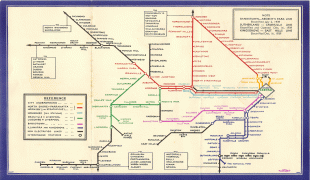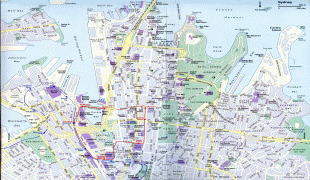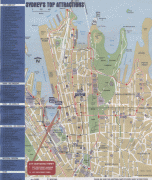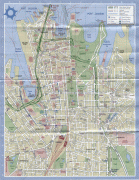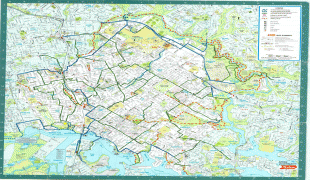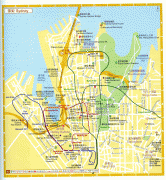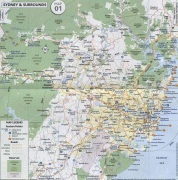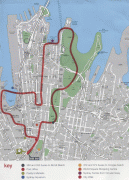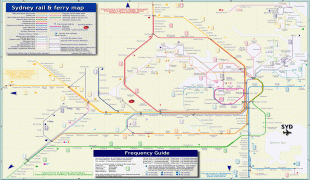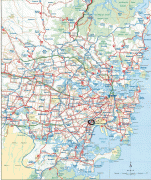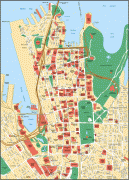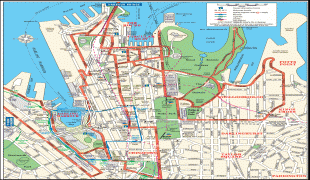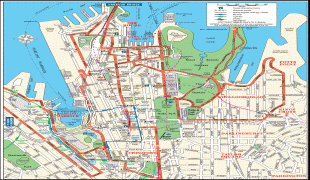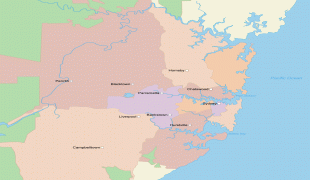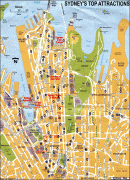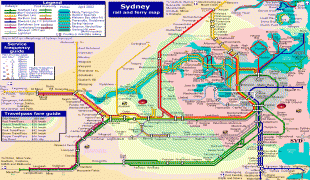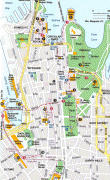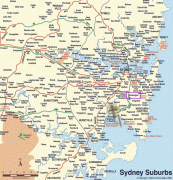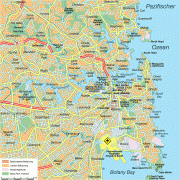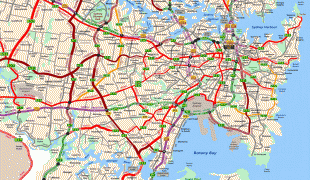Sydney
Sydney is the capital city of the state of New South Wales, and the most populous city in both Australia and Oceania. Located on Australia's east coast, the metropolis surrounds Sydney Harbour and extends about 70 km towards the Blue Mountains to the west, Hawkesbury to the north, the Royal National Park to the south and Macarthur to the south-west. Sydney is made up of 658 suburbs, spread across 33 local government areas. Residents of the city are known as "Sydneysiders". The 2021 census recorded the population of Greater Sydney as 5,231,150, meaning the city is home to approximately 66% of the state's population. Nicknames of the city include the 'Emerald City' and the 'Harbour City'.
Aboriginal Australians have inhabited the Greater Sydney region for at least 30,000 years, and Aboriginal engravings and cultural sites are common throughout Greater Sydney. The traditional custodians of the land on which modern Sydney stands are the clans of the Darug, Dharawal and Eora peoples.
During his first Pacific voyage in 1770, James Cook charted the eastern coast of Australia, making landfall at Botany Bay. In 1788, the First Fleet of convicts, led by Arthur Phillip, founded Sydney as a British penal colony, the first European settlement in Australia. After World War II, Sydney experienced mass migration and by 2021 over 40 per cent of the population was born overseas. Foreign countries of birth with the greatest representation are Mainland China, India, England, Vietnam and the Philippines.
Despite being one of the most expensive cities in the world, Sydney frequently ranks in the top ten most liveable cities in the world. It is classified as an Alpha global city by the Globalization and World Cities Research Network, indicating its influence in the region and throughout the world. Ranked eleventh in the world for economic opportunity, Sydney has an advanced market economy with strengths in finance, manufacturing and tourism. Established in 1850, the University of Sydney was Australia's first university and is regarded as one of the world's leading universities.
Sydney has hosted major international sporting events such as the 2000 Summer Olympics. The city is among the top fifteen most-visited cities in the world, with millions of tourists coming each year to see the city's landmarks. The city has over 1,000,000 ha of nature reserves and parks, and its notable natural features include Sydney Harbour and Royal National Park. The Sydney Harbour Bridge and the World Heritage-listed Sydney Opera House are major tourist attractions. Central Station is the hub of Sydney's rail network, and the main passenger airport serving the city is Kingsford Smith Airport, one of the world's oldest continually operating airports.
In 1788, Captain Arthur Phillip, the first governor of New South Wales, named the cove where the first British settlement was established Sydney Cove after Home Secretary Thomas Townshend, 1st Viscount Sydney. The cove was called Warrane by the Aboriginal inhabitants. Phillip considered naming the settlement Albion, but this name was never officially used. By 1790 Phillip and other officials were regularly calling the township Sydney. The town of Sydney was declared a city in 1842.
The Gadigal (Cadigal) clan, whose territory stretches along the southern shore of Port Jackson from South Head to Darling Harbour, are the traditional owners of the land on which the British settlement was initially established, and call their territory Gadi (Cadi). Aboriginal clan names within the Sydney region were often formed by adding the suffix "-gal" to a word denoting the name for their territory, a specific place in their territory, a food source, or totem. The modern Greater Sydney area covers the traditional lands of 28 known Aboriginal clans.
Aboriginal Australians have inhabited the Greater Sydney region for at least 30,000 years, and Aboriginal engravings and cultural sites are common throughout Greater Sydney. The traditional custodians of the land on which modern Sydney stands are the clans of the Darug, Dharawal and Eora peoples.
During his first Pacific voyage in 1770, James Cook charted the eastern coast of Australia, making landfall at Botany Bay. In 1788, the First Fleet of convicts, led by Arthur Phillip, founded Sydney as a British penal colony, the first European settlement in Australia. After World War II, Sydney experienced mass migration and by 2021 over 40 per cent of the population was born overseas. Foreign countries of birth with the greatest representation are Mainland China, India, England, Vietnam and the Philippines.
Despite being one of the most expensive cities in the world, Sydney frequently ranks in the top ten most liveable cities in the world. It is classified as an Alpha global city by the Globalization and World Cities Research Network, indicating its influence in the region and throughout the world. Ranked eleventh in the world for economic opportunity, Sydney has an advanced market economy with strengths in finance, manufacturing and tourism. Established in 1850, the University of Sydney was Australia's first university and is regarded as one of the world's leading universities.
Sydney has hosted major international sporting events such as the 2000 Summer Olympics. The city is among the top fifteen most-visited cities in the world, with millions of tourists coming each year to see the city's landmarks. The city has over 1,000,000 ha of nature reserves and parks, and its notable natural features include Sydney Harbour and Royal National Park. The Sydney Harbour Bridge and the World Heritage-listed Sydney Opera House are major tourist attractions. Central Station is the hub of Sydney's rail network, and the main passenger airport serving the city is Kingsford Smith Airport, one of the world's oldest continually operating airports.
In 1788, Captain Arthur Phillip, the first governor of New South Wales, named the cove where the first British settlement was established Sydney Cove after Home Secretary Thomas Townshend, 1st Viscount Sydney. The cove was called Warrane by the Aboriginal inhabitants. Phillip considered naming the settlement Albion, but this name was never officially used. By 1790 Phillip and other officials were regularly calling the township Sydney. The town of Sydney was declared a city in 1842.
The Gadigal (Cadigal) clan, whose territory stretches along the southern shore of Port Jackson from South Head to Darling Harbour, are the traditional owners of the land on which the British settlement was initially established, and call their territory Gadi (Cadi). Aboriginal clan names within the Sydney region were often formed by adding the suffix "-gal" to a word denoting the name for their territory, a specific place in their territory, a food source, or totem. The modern Greater Sydney area covers the traditional lands of 28 known Aboriginal clans.
Map - Sydney
Map
Country - Australia
 |
 |
| Flag of Australia | |
The ancestors of Aboriginal Australians began arriving from south east Asia approximately 65,000 years ago, during the last ice age. Arriving by sea, they settled the continent and had formed approximately 250 distinct language groups by the time of European settlement, maintaining some of the longest known continuing artistic and religious traditions in the world. Australia's written history commenced with the European maritime exploration of Australia. The Dutch navigator Willem Janszoon was the first known European to reach Australia, in 1606. In 1770, the British explorer James Cook mapped and claimed the east coast of Australia for Great Britain, and the First Fleet of British ships arrived at Sydney in 1788 to establish the penal colony of New South Wales. The European population grew in subsequent decades, and by the end of the 1850s gold rush, most of the continent had been explored by European settlers and an additional five self-governing British colonies established. Democratic parliaments were gradually established through the 19th century, culminating with a vote for the federation of the six colonies and foundation of the Commonwealth of Australia on 1 January 1901. Australia has since maintained a stable liberal democratic political system and wealthy market economy.
Currency / Language
| ISO | Currency | Symbol | Significant figures |
|---|---|---|---|
| AUD | Australian dollar | $ | 2 |
| ISO | Language |
|---|---|
| EN | English language |






